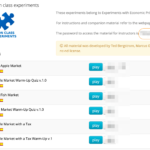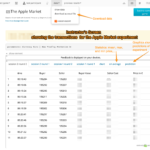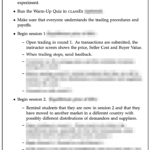You can start by reading the Instructor’s Manual for any of the experiments. Experiments are self-contained and instructions are written to allow running each experiment independently, yet they share a similar core structure. The Apple Market is the simplest experiment and perhaps a good starting point if you have not run experiments before.
Each experiment includes an instructor’s manual, a student’s manual, a warm-up quiz, and Excel files that automatically generate solutions to the exercises and report participation, profits and the number of correct answers to the warm-up quiz (in case you want to keep records), based on the files provided by classEx. The student’s manual is provided in three separate documents: Instructions for participants, Exercises, and Theory and Discussion. Students should read the Instructions for participants before the experiment. We recommend using Exercises and Theory and Discussion material after the experiment to reflect on the experience and the findings. See the experiential learning section for suggestions on using the material on your classes.
All experiments are implemented in classEx and available in the folder “econ class experiments” within classEx. The classEx documentation provides information on how to get started in classEx and on how to run ready-made games.









